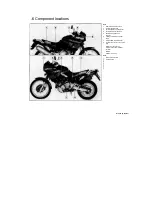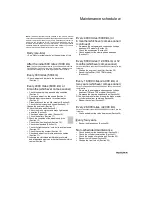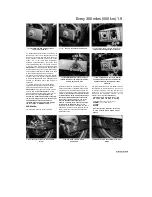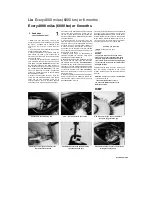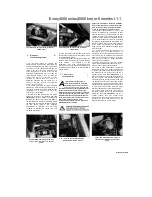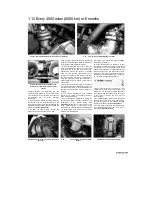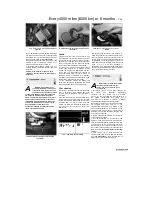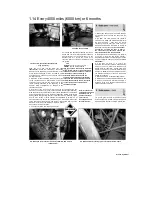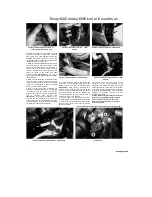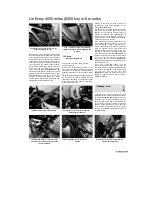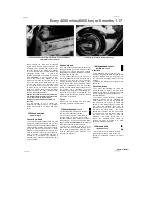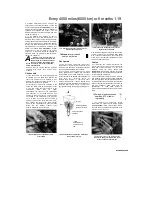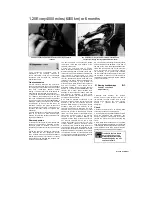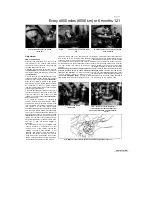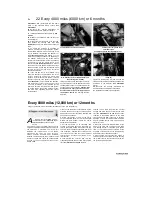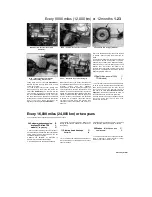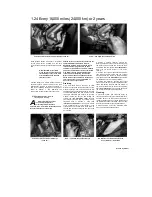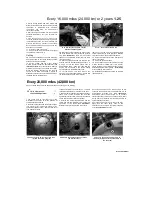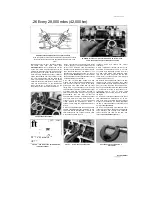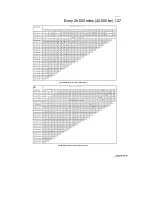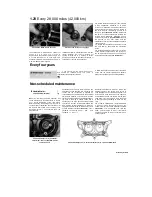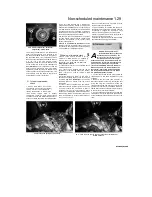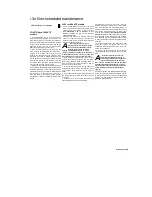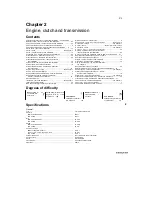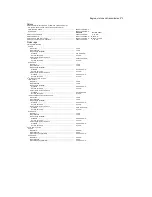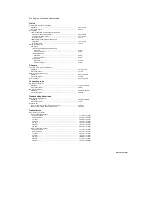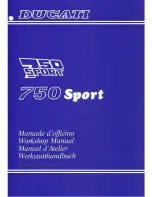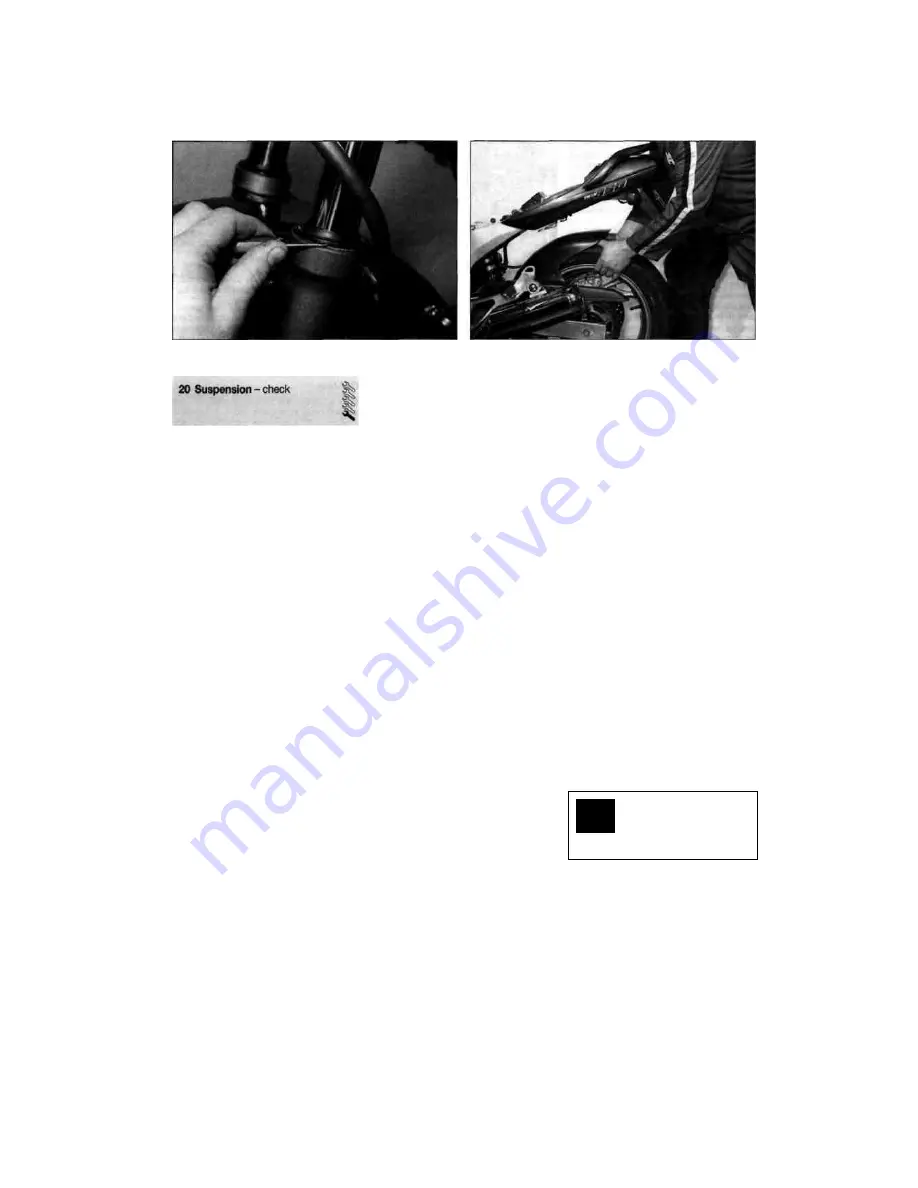
1.20 Every 4000 miles (6000 km) or 6 months
20.3 Check above and below the dust seal for signs of fluid
leakage
20.7 Checking for play in the rear shock mountings and
suspension linkage bearings (TRX and XTZ models)
1
The
suspension
components
must
be
maintained in top operating condition to
ensure rider safety. Loose, worn or damaged
suspension parts decrease the motorcycle's
stability and control.
Front suspension
2 While standing alongside the motorcycle,
apply the front brake and push on the handlebars
to compress the forks several times. Check that
they move up-and-down smoothly without
binding. If binding is felt, the forks should be
disassembled and inspected (see Chapter 6).
3 Inspect the area around the dust seal for signs
of oil leakage, then carefully lever up the dust
seal using a flat-bladed screwdriver and inspect
the area around the fork seal
(see illustration).
If
leakage is evident, the seals must be renewed
(see Chapter 6). Check the fork tubes for
scratches, corrosion and pitting as these will
cause premature seal failure. If the damage is
excessive the tubes should be renewed (see
Chapter 6).
4 Check the tightness of all suspension nuts and
bolts to be sure none have worked loose,
referring to the torque settings specified at the
beginning of Chapter 6.
Rear suspension
5 Inspect the rear shock for fluid leakage and
tightness of its mountings. If leakage is found,
the shock should be renewed or taken to a
suspension specialist for overhaul (see Chapter
6).
6 With the aid of an assistant to support the
bike, compress the rear suspension several
times. It should move up and down freely without
binding. If any binding is felt, the worn or faulty
component must be identified and renewed. The
problem could be due to either
the shock absorber, the suspension linkage
components (TRX and XTZ models) or the
swingarm components.
7 Support the motorcycle using an auxiliary
stand so that the rear wheel is off the ground.
Grab the swingarm and rock it from side to side -
there should be no discernible movement at the
rear. If there's a little movement or a slight
clicking can be heard, inspect the tightness of all
the rear suspension mounting bolts and nuts,
referring to the torque settings specified at the
beginning of Chapter 6, and re-check for
movement. Next, grasp the top of the rear wheel
and pull it upwards - there should be no
discernible freeplay before the shock absorber
begins to compress
(see illustration).
Any
freeplay felt in either check indicates worn
bearings in the suspension linkage (TRX and
XTZ models) or swingarm, or worn shock
absorber mountings. The worn components must
be renewed (see Chapter 6).
8 To make an accurate assessment of the
swingarm bearings, remove the rear wheel (see
Chapter 7) and the bolt securing the shock
absorber (TDM models) or suspension linkage
assembly (TRX and XTZ models) to the
swingarm (see Chapter 6). Grasp the rear of the
swingarm with one hand and place your other
hand at the junction of the swingarm and the
frame. Try to move the rear of the swingarm from
side-to-side. Any wear (play) in the bearings
should be felt as movement between the
swingarm and the frame at the front. If there is
any play the swingarm will be felt to move
forward and backward at the front (not from side-
to-side). Yamaha specify a maximum lateral
movement of 1 mm measured at the rear ends of
the swingarm. Next, move the swingarm up and
down through its full travel. It should move freely,
without any binding or rough spots. If any play in
the swingarm is noted or if the swingarm does
not move freely, the bearings must be removed
for inspection or renewal (see Chapter 6).
9 On XTZ models, the swingarm sideplay should
be measured. Push the swingarm to one side of
the frame, then slip a feeler gauge between the
frame and the swingarm cap on the side from
which the swingarm was pushed and measure
the clearance. If it is greater than specified,
remove the swingarm (see Chapter 6) and follow
the procedure in Section 14 of that Chapter to
calculate the shims required to restore sideplay
to the correct amount.
21 Steering head bearings
-
freeplay check and
adjustment s|
1 Steering
head
bearings
can
become
dented, rough or loose during normal use of
the machine. In extreme cases, worn or loose
steering head bearings can cause steering
wobble - a condition that is potentially
dangerous.
Check
2 Support the motorcycle on an auxiliary stand
so that the front wheel is off the ground.
3 Point the front wheel straight-ahead and slowly
move the handlebars from side-to-side. Any
dents or roughness in the bearing races will be
felt and the bars will not move smoothly and
freely.
4 Next, grasp the fork sliders and try to pull and
push them forward and backward. Any looseness
in the steering head bearings will be felt as front-
to-rear movement of the forks. If play is felt in the
bearings, adjust the steering head as follows.
HAYNE
S
TR7T
5
Freeplay in the fork due to
worn fork bushes can be
misinterpreted for steering
head bearing play - do not
confuse the two.
Scaned by Stalker
&>

